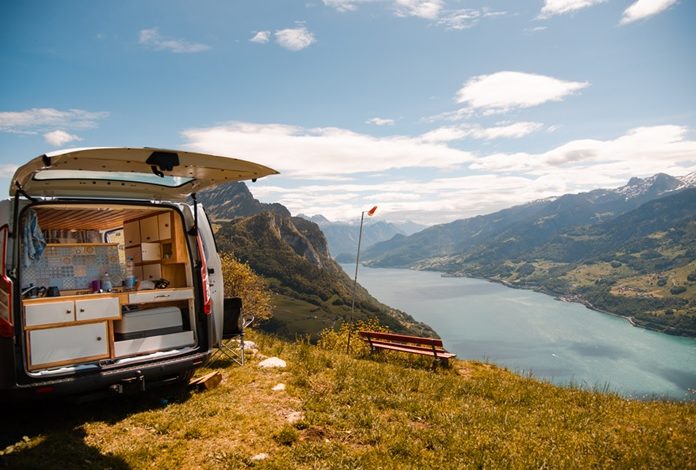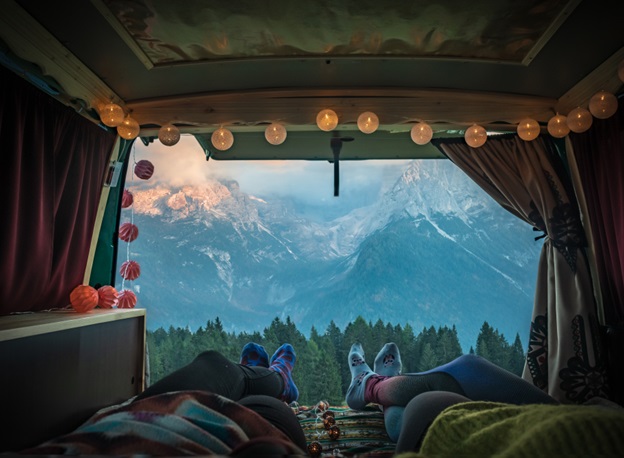A Beginner’s Guide to Van Life

So, you want to live out of a van but you’re not sure how? We’ve got all the info you need to start your #vanlife. You’ve probably seen the hashtag all over social media as of late. The high cost of buying a home has convinced millions of people to forgo a mortgage and start living on the road instead. Some 3.1 million Americans were subscribing to this lifestyle in 2022. But what does it really mean to live in a van?
Van life is defined as living out of a vehicle that has been converted into a portable living space. The van becomes your main source of shelter from the outdoors as you venture from one destination to the next. For many people, #vanlife is about more than just saving money. It’s about getting back to nature and seeing where life takes you. You still need to pay for gas, food, and other essentials, but you won’t have to worry about paying rent. Some people choose to work remotely by installing a Wi-Fi hookup in their vehicle, while others use this time to focus on the journey. Learn how to prepare for a life behind the wheel of a van, from van maintenance and essential diesel parts to traveling tips.
Choosing a Van
It all starts with finding a new home, preferably one that travels on four wheels. There are lots of makes and models to choose from, including minivans, cargo vans, sprinter vans, campers, and sprinter van conversions. The van should be large enough to accommodate you and your fellow travelers. A sprinter van will give you space to lie down in the back with plenty of overhead storage. Consider finding a vehicle with four-wheel drive if you plan on exploring off-road areas. Some campsites may be bogged down by mud, ice and snow, so make sure you can get in safely.

Source:Pawel Gluza/Shutterstock.com
Regardless of which vehicle you choose, the van must be fully inspected and repaired before you depart. If you are using an older vehicle, like your uncle’s VW van, the vehicle may need significant repairs. Head over to a local mechanic or open the hood yourself to get a better look at the engine. Replace rusted parts and watch out for cracks that could spring a leak in the future. Most of these vans have diesel engines, which require special parts. Save money on repairs by ordering your diesel truck parts online.
Your van will need a steady supply of clean, high-quality oil to go the extra mile on the road. The oil lubricates parts to create a smooth mechanical motion. Pay special attention to the vehicle’s oil system, including the oil pump, gaskets, fuel injectors, and oil cooler. Replace the oil cooler gasket to prevent leaks that will drain the system. Bring along everything you will need to maintain your vehicle in case you run into problems along the way. You might need help finding a mechanic in some areas, so you should do your best to fix the issues yourself. You’ll need tools, oil, coolant, spare parts, and cold-start accessories when driving in the winter.
Converting the Space
Be strategic when setting up the space. The modification process can take anywhere from three weeks to three years depending on your experience level and the scope of the operation. Start by planning out where everything will go, including the bed/mattress, kitchenette, and bathroom. You’ll likely need an additional battery to power your electronics. Install a solar battery to draw power from the sun during the day, so you don’t wake up to a dead battery after charging your phone. You may want to add paneling and shelves to stay organized and divide up the space. Most beds won’t fit in the back, so consider making your own out of wood.
Don’t forget to insulate the space to slow the heat transfer rate in the summer. It will also help you stay warm in the winter. Use non-toxic materials such as certain types of spray foam and polystyrene. You’ll also need to add some appliances, including a hot water heater, electric stove, or microwave. Consider buying a premade van life kit to simplify the conversion process.

Source:photoschmidt/Shutterstock.com
Life on the Road
Once the vehicle has been converted and you’ve packed the car with essentials, including food, water, first-aid supplies, camping equipment, and survival essentials, it’s time to start gearing up for your trip. You can choose to follow a certain route if you have a particular destination in mind or just start driving. You’ll need to find a safe place to park your van at night. Campsites tend to be best for van lifers. You can spend time in nature and meet other like-minded individuals. Consider traveling to a van life convention or popular nomad destination to build relationships in the community.
You might be able to spend the night in a parking lot, but some businesses don’t want a bunch of RVs and vans filling the space. Check with the owner or manager to see if you are welcome to spend the night. Stores like Bass Pro Shops, Cabela’s, and even Cracker Barrel tend to be safe. Living out of a van isn’t for the faint of heart. It requires a lot of prep work and improvisation. You don’t want to get stranded in an unfamiliar location. Use this guide to start your #vanlife off on the right foot.
Source:RoMiEg/Shutterstock.com






